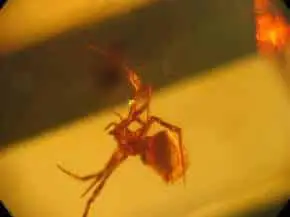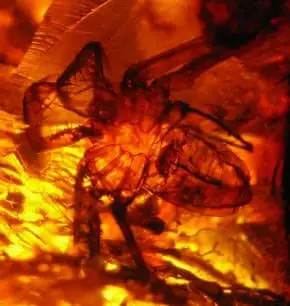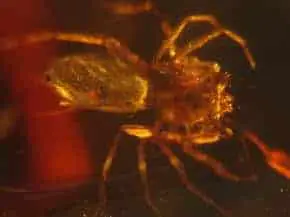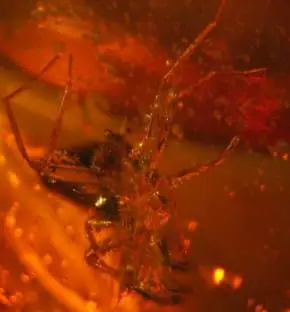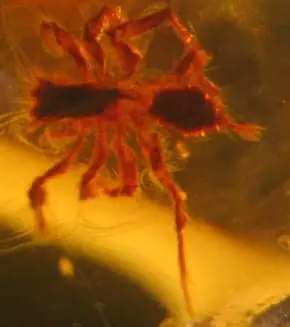Table of Contents
Dinosaur-Era Spiderweb Found in Amber
John Pickrell in England for National Geographic News
August 7, 2003
Over a hundred millions years ago, one small spider wove its intricate silken web—a task spiders are thought to have performed for hundreds of millions of years. This spider lived during the Cretaceous period in what is now Lebanon, and shared its world with some of the largest dinosaurs to have ever existed.
But on this rare occasion one small piece of that delicate web became trapped in oozing, tar-like, tree resin, which later hardened to form amber. One hundred thirty million years or so would pass before fossil hunters dug it up, and now that miraculously fossilized spider’s web is described for the first time in today’s issue of the science journal Nature.
The fossil, described by Samuel Zschokke, a spider biologist at the University of Basel in Switzerland, is the oldest direct evidence of spiderwebs.
“Spiders are amongst the rarest of all fossils,” commented William Shear, an entomologist at Hampden-Sydney College in Virginia. “We almost never find web fossils, and this is undoubtedly the oldest,” he said.
Spiders don’t fossilize well, as they have no hard skeleton and are not typically found near bodies of water, which readily accumulate the sediments ideal for preservation.
Polished and Put Aside
Though spider thread preserved in amber has been found before, previous specimens have dated from much more recent periods—typically from amber beds some 20 to 30 million years old, deposited long after the extinction of the dinosaurs. But the newly described fossil spiderweb dates roughly 90 million years older than the previous oldest known specimen.
The piece of amber was found in Jezzine, Lebanon, by German fossil hunter Dieter Schlee in 1969 in amber beds that date to between 127 and 132 million years ago. The amber beds are from the early Cretaceous period and are the oldest beds known to contain fossilized insects.
Though Schlee noted that the fossil might contain a piece of web, it wasn’t his area of expertise, so the fossil was polished and put aside in a Stuttgart museum, without the recognition it deserved.
That was until Zschokke recently paid a visit to the museum, and asked staff if he could examine their amber collection. What he found on inspection with a microscope astounded him.
The tiny thread of silk is just four millimeters (0.15 inch) long and just three micrometers in diameter (a micrometer is one-thousandth of a millimeter and approximately one twenty-five-thousandth of an inch). That’s many times thinner than a human hair.
The thread was only noticed because it is coated in larger glue droplets, deposited by many species of spider. All spiders known to weave delicate circular net-like orb webs are spiders of the superfamily Araneoidea who produce this kind of glue coated “viscid” silk. The thread shows “a striking resemblance to recent araneoid spider threads,” said Zschokke.
Araneoid spiders are a very successful group numbering 12,000 to 13,000 known species today, said Jonathan Coddington, an expert on spider systematics at the Smithsonian Institution in Washington, D.C. Though an entire araneoid spider has also been found in amber from this period, this new find provides independent evidence for the great age of that group, said Coddington.
The development of sticky viscid silk is thought to be an important evolutionary innovation as that silk is more effective at snagging passing insects than the non-sticky variety. “It allowed spiders to economize on silk,” said Shear. Many spiders have to build a web from scratch again each day. Producing all that silk uses a lot of energy.
Weaving Webs in Deep Time
Though scientists have some evidence that spiders have been weaving webs for hundreds of millions of years, much of it has been circumstantial.
Shear noted that while the araneoid spider fossil contained so-called spinneret organs, adaptations also used by modern spiders to produce silk for webs, it’s not possible to be certain that fossilized structures performed the same function that similar-looking structures perform today. But the fact that ancient specimen has comb structures on its feet—which aid modern spiders’ movement on a web—adds further evidence.
The oldest confirmed spider fossil was found embedded in ancient rock deposits dating to the mid-Devonian period 380 million years ago, long before the appearance of four-footed vertebrates. This specimen has fully-formed spinneret organs, said Shear, and is strong evidence that spiders were already producing silk at that time. Another small fossil dates to 415 million years ago, but is not complete enough to confirm that it is part of a spider.
Finding spinnerets alone is not proof enough of web building, as primitive spiders must originally have used the silk for another less-complex task, said Coddington. Lining burrows, and creating eggs sacs (which spiders still do with silk) are likely contenders, he said.
“This new find is conclusive evidence that Cretaceous-era spiders were producing viscid silk,” said Shear. “We are unlikely to find any older [pieces of web] because this is one of the oldest amber deposits,” he said.
Amber deposits only appear in the fossil record in abundance following the proliferation of modern flowering plants during the Cretaceous period.
Story – National Geographic
Here’s some photos of spiders found in amber from the Chiapas highlands near the town of Simojovelamber. Chiapas amber is between 22 million and 26 million years old and comes from the resin of the Hymenaea Leguminoseae tree.
All photos are copyright to their owners and may not be reproduced without permission.

